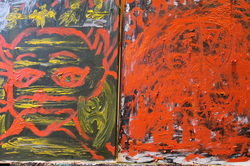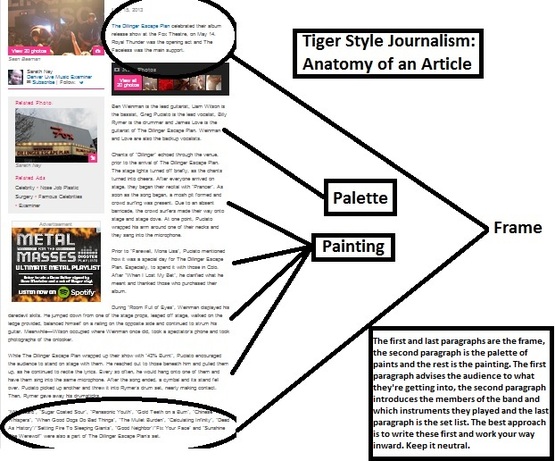Tiger Style journalism is...

"Tiger Style Journalism" is "Finding Peace In Chaos".
AP Style + Chicago Style x Gonzo Style (Hunter S. Thompson) = Tiger Style Journalism. AP Style and Chicago Style are the traditional forms of journalism. Hunter S. Thompson used to write for “Rolling Stone Magazine”. Tiger Style Journalism pays homage to all three and the Wu-Tang Clan.
Imagine being the disc jockey at a radio station. The first thing you must do is open dedication lines, like Casey Kasem. You don’t want to let your audience know who you are seeing or where you’re going, until the second dedication line is open. The reason being is you want to “Protect Ya Neck”.
When you arrive to the venue, make sure you buy merchandise from the band you are covering. It is your way of thanking them for granting free admission, writing and photographing them and it will help get them to their next destination.
At most venues, you get to take photos in the “Gravel Pit” for the first three songs. There is an energy which passes through, which Method Man often speaks about exchanging energies. This vitality is bartered between the audience and artist. The feeling is indescribable and you never want to let go.
Prior to painting of the picture with words, one must bring with them several tools: a journal (“The Wu-Tang Manual” or “The Tao of Wu”), pens (“Liquid Swords”) and a digital camera (“Bobby Digital” photography). One might encounter obstacles such as writing in the dark, an attempt to catch up to real-time, difficulty writing with movement by the fans and injury due to crowd surfing and moshing.
Imagine the article as if it were a painting. The first and last paragraphs are the frame, the second paragraph is the palette of paints and the rest is the painting. The first paragraph advises the audience to what they're getting into, the second paragraph introduces the members of the band and which instruments they played and the last paragraph is the set list. The best approach is to write these first and work your way inward. Keep it neutral.
One has to have the discipline to use 400 words to tell a story, including the three paragraphs mentioned prior. The first word of each must not be the same as the others either. There must be a beginning, middle and end. Each paragraph must be between three and five lines on a Microsoft Word document.
Imagine being the disc jockey at a radio station. The first thing you must do is open dedication lines, like Casey Kasem. You don’t want to let your audience know who you are seeing or where you’re going, until the second dedication line is open. The reason being is you want to “Protect Ya Neck”.
When you arrive to the venue, make sure you buy merchandise from the band you are covering. It is your way of thanking them for granting free admission, writing and photographing them and it will help get them to their next destination.
At most venues, you get to take photos in the “Gravel Pit” for the first three songs. There is an energy which passes through, which Method Man often speaks about exchanging energies. This vitality is bartered between the audience and artist. The feeling is indescribable and you never want to let go.
Prior to painting of the picture with words, one must bring with them several tools: a journal (“The Wu-Tang Manual” or “The Tao of Wu”), pens (“Liquid Swords”) and a digital camera (“Bobby Digital” photography). One might encounter obstacles such as writing in the dark, an attempt to catch up to real-time, difficulty writing with movement by the fans and injury due to crowd surfing and moshing.
Imagine the article as if it were a painting. The first and last paragraphs are the frame, the second paragraph is the palette of paints and the rest is the painting. The first paragraph advises the audience to what they're getting into, the second paragraph introduces the members of the band and which instruments they played and the last paragraph is the set list. The best approach is to write these first and work your way inward. Keep it neutral.
One has to have the discipline to use 400 words to tell a story, including the three paragraphs mentioned prior. The first word of each must not be the same as the others either. There must be a beginning, middle and end. Each paragraph must be between three and five lines on a Microsoft Word document.
